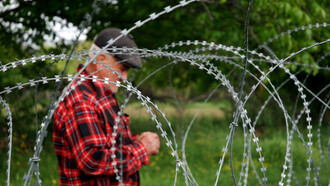The strategies employed by the European Commission to address the phenomenon of migration have predominantly focused on criminalizing migration, intensifying border control measures, and externalizing migration management beyond the boundaries of the European space. This has entailed the implementation of migration management operations in external locations, including Libya, Turkey, and most recently, Albania. The intensification of border enforcement has been accompanied by a corresponding increase in smuggling activities, which have become a global business1. Enforcement measures and human smuggling practices tend to intensify in concert; as one increases, so too does the other. As border control expands, the prices paid to human smugglers and the risks taken by migrants escalate2. The primary objective of these strategies has been to filter migration flows, with minimal effort to redirect EU migration and asylum policies in a less securitized direction.
Conversely, once the migrants reach Europe, another “business” takes place: the so-called business of hospitality. For the Italian case, authorities have outsourced to charities, private companies, and cooperatives the task of taking care of migrants upon their arrival in the country. As this became a lucrative business, the system gave rise to scandals involving corruption and the influence of organized crime3. Indeed, the majority of reception centers are under the control of a limited number of management bodies, which in some cases have the ability to exercise a monopoly-like influence.
The business of borders and hospitality: profiting from people in need
The recently devised plan, which the Italian government has chosen to implement in collaboration with Albania, serves to exemplify this phenomenon. The plan entails the transfer of migrants rescued in the Mediterranean Sea to Albanian soil who originate from countries deemed safe by the Italian government. Following a 28-day period, these migrants are expected to be relocated to another center in Albania, where they will await repatriation. Two centers have been constructed in Albania: one in Schengjin for the identification of migrants rescued or caught at sea, and one in Gjader for repatriation. The estimated cost of these projects ranges from 650 million to 800 million euros, according to various sources. The plan will be in effect for a period of five years, with the option of extending it for another five years. An advance of 16.5 million euros will be provided to Albania, to be credited by the Italian side to the Albanian side within 90 days of the protocol's entry into force. Additionally, over 100 million euros will be frozen in a second-tier bank account as collateral4.
The power to choose and welcome those who come in, those who are allowed to be relocated to Italy to process asylum claims, and those who are forced to be brought to Albania because they are considered "not in danger enough" and therefore safe to return to their own countries is exercised through the use of exclusion. The power of controlling, administering, and mastering someone’s life is selective, contingent upon, and results in the management of bodies. In terms of migratory flows and hospitality, the binary construction of the host (here being Italy and to a further extent Europe) and the guest (being the migrant) maintains the division between power and powerlessness, all the while a commercial logic pervades the relation between the migrant Other and the host country (Rosello 2001). The commercial logic behind the business, or, let's call it, the system of hospitality, entails a calculative scheme taking place: risk assessment and risk management are laid out while profitable outcomes and business strategies are implemented. In these schemes, ethical values in welcoming migrants are deliberately eroded to give space to financial interests.
The pact between Italy and Albania, which could even be a violation of international law, is a plan that only protects the interests of the two parties: Albania and Italy. For Italy, the migrants are out of sight, and for Albania, there is a possibility of the country's future accession to the EU. Such a move is a response to the fact that the Italian government is eager to show voters that it is speeding up deportations of migrants who have been denied permission to stay. For migrants, the detention center, or as it's called in the media, the "return hub," but let's be honest, it looks more like a prison than a hub, is instead a junction that interrupts and redirects their journey—by forcibly returning them. It is one of the many measures used by border control to impede the passage of migrants and to enforce the quality of the border as a filter that allows one path to continue on the one hand and to be redirected elsewhere by detention, deportation, or expulsion on the other.
In this light, the detention facility is a component of the border regime whose process of bifurcation constantly redirects flows of people across or away from the border itself. Such a filtering process increases the speed of trustworthy travelers while reducing and eventually blocking and detaining life patterns that deviate from the established norm. In this way, migrants are deliberately stopped from entering the EU space. Europe thus appears as a fortress, not only because of the impossibility of entering it but also in light of the theoretical debate that tends to consider measures of detention and "deterrence" of migrants from entering the EU as mere side effects of migration policies.
Impenetrable borders: the weakness behind Europe's strength
The strategies adopted by the European Commission and individual member states such as Italy highlight a disturbing trend towards the criminalization and externalization of migration management. These policies not only exacerbate the risks faced by migrants but also fuel a lucrative and often corrupt business of hospitality. The recent pact between Italy and Albania illustrates the ethical and legal dilemmas inherent in such policies, which prioritize national interests over humanitarian considerations. To address these challenges, it is imperative to move towards more humane and ethical migration policies.
This includes enhancing legal channels for migration, improving conditions in reception centers, and ensuring transparency and accountability in the management of migration. Such a step is imperative in order to steer the path that Europe has decided to take. In 2026, a new reform of the asylum system will take place. The reform aims to simplify procedures at the Union's borders, which may result in more asylum seekers being detained at Europe's external borders and, consequently, these people being excluded from entering the territory of the European Union. As a final note to the discussion, I would like to recall that the construction of borders represents an opposite desire to be protected, namely fear.
Every practice of demarcation, selection, and inclusion produces its own fear, specifically the fear of what it excludes. The desire to be completely isolated, walled in, leads to self-destruction. The regressive impulse to construct and spread impenetrable borders is definitely not a sign of power but of weakness and self-annihilation. In their spectacle of supposed strength, impenetrable borders are the image of sovereign power in the face of its own demise. Borders not only consolidate the false notion of a homogeneous and united community on each side but also carry with them the misleading idea of protecting the “inside” from any contamination by a threatening "outside." The result of erecting supposedly impenetrable borders is the self-annihilation of the "inside.”
References
1 Mountz, Alison and Hiemstra, Nancy (2012). “Spatial Strategies for Rebordering Human Migration at Sea”, in A Companion to Border Studies, Wilson, T.M. And Donnan, H. eds. Oxford: Wiley-Blackwell, pp. 455-472.
2 Nadig, Anania (2002). “Human smuggling, national security, and refugee protection”, Journal of Refugee Studies, vol. 15, no. 1, pp. 1- 25.
3 Castelli Gattinara, Pietro (2017). “The 'refugee crisis' in Italy as a crisis of legitimacy”, Contemporary Italian Politics, vol 9, no. 3, pp. 318-331.
4 Guerzoni, Monica. 2024. "Che cosa darà l'Italia all'Albania per i migranti: 16,5 milioni di anticipo e 100 di garanzia, (più il sostegno per la UE)." Corriere della Sera.















